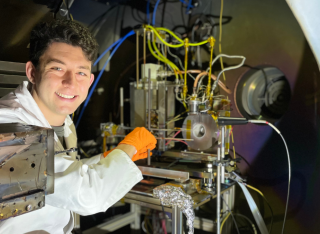
Dr Mansur Tisaev
About
My research project
Air-breathing electric propulsionThe PhD investigates electric propulsion technologies for a spacecraft in very low Earth orbit (VLEO) using upper atmospheric air as propellant. This includes experimental development of novel components for such a thruster system and computational simulations analysing thruster control for long-term orbital stability.
Supervisors
The PhD investigates electric propulsion technologies for a spacecraft in very low Earth orbit (VLEO) using upper atmospheric air as propellant. This includes experimental development of novel components for such a thruster system and computational simulations analysing thruster control for long-term orbital stability.
Publications
Air-breathing electric propulsion (ABEP) systems offer a potential solution for sustained spacecraft operations in Very Low Earth Orbit (VLEO), by utilizing atmospheric particles as propellant, thereby reducing dependence on onboard fuel. This work presents the design, feasibility, and orbital performance of the ABEP spacecraft EULO, intended to operate near 200 km with a high resolution optical Earth observation payload. A preliminary 550 kg spacecraft was designed to meet mass, power, and aerodynamic constraints while fitting within a UK based launcher, RS-1. The orbital performance of the satellite was simulated with a high-fidelity propagator coupled with a panel based aerodynamic force estimation method using gas-surface interaction models evaluated at each time step. This geometric framework, compared to a classic cannonball model, enables modelling of thespacecraft’s attitude, which in this study was held constant and either aligned with the orbital velocity or the local flow. Simulations on a generic ABEP spacecraft highlighted that misalignments with the relative flow can significantly affect orbital stability, with some configurations experiencing de-orbiting due to such misalignments. Furthermore, the EULO spacecraft demonstrated sustained a simulated flight at 255 km, achieving a theoretical ground sampling distance of 0.38 m and requiring the intake to have a collection efficiency of 50%. Nevertheless, uncertainties in the aerodynamic modelling suggests that improving thruster performance will be essential to mitigate these uncertainties.
PLATOR is a new electrothermal thruster for space logistics applications, developed by the University of Surrey and the University of Leicester. This paper describes the technology behind the development of the thruster and presents a mission scenario where a PLATOR-propelled spacecraft is used to capture and de-orbit the European Space Agency (ESA)'s Envisat satellite. The orbital transfer trajectory is designed using a time-optimal control approach, and the spacecraft's state vector's uncertainties are assessed through a covariance analysis. A navigation analysis is then performed to evaluate the spacecraft's capability to autonomously track its motion during the transfer using GPS measurements. Finally, a target proximity phase is then simulated to demonstrate the spacecraft's capability to rendezvous and dock with Envisat, using the uncertainties obtained from the covariance analysis, showing the potential of the PLATOR thruster for in-orbit servicing and active debris removal applications.
The possibility of efficiently exploiting Very Low Earth orbits (VLEO) poses significant technological challenges. One of the most demanding constraints is the need to counteract the drag generated by the interaction of the spacecraft with the surrounding atmosphere. Funded by the European Commission under the H2020 programme, the Air-breathing Electric THrustER (AETHER) project aims at developing the first propulsion system able to maintain a spacecraft at very-low altitudes for an extended time. The main objective of the project is to demonstrate, in a relevant environment, the critical functions of an air-breathing electric propulsion system, and its effectiveness in compensating atmospheric drag. This achievement will involve multiple research activities, among which: (i) the characterization of specific application cases through an extensive market analysis in order to define specific requirements and constraints at different design levels, (ii) fulfilment of pertinent testing conditions of flight conditions on-ground, relevant to the specific mission cases, (iii) the development of critical technologies, in particular those relevant to the collection, the ionization and the acceleration of rarefied atmospheric mixtures and (iv) the testing of the RAM-EP thruster to assess the system performance. In this paper, the main activities foreseen in the AETHER project are described, providing the detailed perspective towards an effective exploitation of the project outcomes for a possible future in-orbit demonstration.
Abstract The air-breathing electric propulsion (ABEP) concept refers to a spacecraft in very-low Earth orbit (VLEO) ingesting upper atmospheric air as propellant for an electric thruster. This compensates atmospheric drag and allows the spacecraft to maintain its orbital altitude, removing the need for on-board propellant storage and allowing an extended mission duration which is not limited by propellant exhaustion. There is a need for development of a robust, high current density and long life cathode (or neutralizer) for air-breathing electrostatic thrusters as conventional thermionic hollow cathodes are susceptible to oxygen poisoning. An Air-breathing Microwave Plasma CAThode (AMPCAT) is proposed to overcome this issue through the use of a microwave plasma discharge, producing an extracted current in the order of 1 A with 0.1 mg s-1 of air. In this paper, the effect of varying magnetic-field strength and topology is investigated by using an electromagnet coil, which reveals a significantly different behaviour for air compared to xenon. The extracted current with xenon increases by 3.9 times from the zero-field value up to a peak around 150 mT magnetic-field strength at the antenna, whereas an applied field does not increase the extracted current with air at nominal conditions. A non-zero magnetic-field with air is however beneficial for current extraction at reduced neutral densities. A distinct increase in extracted current is identified at low bias voltages with air for a field strength of around 50 mT at the internal microwave antenna, consistent across varying field topologies. The effect of a lowered magnetic-field strength in the orifice region is investigated through the use of a secondary coil, resulting in an extracted current increase of 25 % for a relaxation from 6 mT to 1 mT, and demonstrating the beneficial impact of a locally reduced field strength on electron extraction.
Air-breathing electric propulsion has the potential to enable space missions at very low altitudes. This study introduces to a 0D hybrid formulation for describing the coupled intake and thruster physics of an air-breathing electric propulsion prototype. Model derivation is then used to formally derive main system's key performance indicators and estimate the figure of merit for the design of rarefied flow air intakes. Achievable performance by conical intake shapes are defined and evaluated by Monte Carlo simulations. Influence of inlet flow variation is assessed by dedicated sensitivity analyses. The set of requirements and optimality conditions derived for the downstream plasma thruster suggest concept feasibility within an achievable performance range.
Air-breathing electric propulsion (ABEP) refers to a spacecraft in very-low Earth orbit (VLEO) harnessing upper atmospheric air as propellant for an electric thruster. This allows the orbital altitude to be maintained via drag-compensation, removing the need for on-board propellant storage and allowing a mission lifetime which is not limited by propellant capacity. A cathode (or neutraliser) is required for the high-specific impulse electrostatic thruster designs proposed for an ABEP application. One such study is the AETHER EU H2020 project, which aims to design an ABEP system that can be tested on-ground in a VLEO-representative environment. There is therefore a need to develop a cathode for ABEP as conventional thermionic hollow cathodes are susceptible to oxygen poisoning. The Air-breathing Microwave Plasma CAThode (AMPCAT) presented here is based on a plasma electron source, using a 2.45 GHz microwave antenna directly-inserted into the plasma volume to ionise neutral air particles. This study details the cathode design and the results of iterative standalone testing, with a particular focus on: (a) the identification of a dual-mode current emission, with transition from lower-to higher-current mode with air at bias values around 70 V between the extracting anode and internal cathode surfaces, (b) a comparison of performance relative to xenon, for which the peak extracted current is 30–40% higher than air at equivalent inputs, and (c) the effect of antenna electrical isolation, using alumina shielding thicknesses in the 0.1–0.7 mm range. Standalone cathode tests demonstrate 0.8 A of stable extracted current with 0.1 mg/s mass flow rate of a 0.48O2 + 0.52N2 mixture, relative bias of 80 V and input microwave power of 70 W. To the authors' knowledge, the demonstration of an extracted current in the 1 A order using air, without visible material degradation after several hours of operation, is a novel development in the cathode literature.
Air-breathing electric propulsion (ABEP) enables long duration missions at very low orbital altitudes through the use of drag compensation. A system-level spacecraft model is developed, using the interaction between thruster, intake and solar arrays, and coupled to a calculation of the drag. A quadratic solution is found for specific impulse and evaluated to identify the thruster performance required for drag-compensation at varying altitudes. An upper altitude limit around 190 km is based on a minimum thruster propellant density, resulting in required thruster performance values of 𝐼𝑠𝑝 > 3000 s and 𝑇 ∕ 𝑃 > 8 mN/kW for a realistic ABEP spacecraft. The orbit of an air-breathing spacecraft is propagated with time, which highlights the prescribed orbit eccentricity due to non-spherical gravity and therefore an increased variability in the atmospheric conditions. A thruster control law is introduced which avoids a divergent altitude behaviour by preventing thruster firings around the orbit periapsis, as well as adding robustness against atmospheric changes due to season and solar activity. Through the use of an initial frozen orbit, thruster control and an augmented 𝑇 ∕ 𝑃 , a stable long-term profile is demonstrated based on the performance data of a gridded-ion thruster tested with atmospheric propellants. An initial mean semi-major axis altitude of 200 km relative to the equatorial Earth radius, a spacecraft mass of 200 kg, 𝐼𝑠𝑝 = 5455 s and 𝑇 ∕ 𝑃 = 23 mN/kW, results in an altitude range of around 10 km at altitudes of 160–183 km during a period of medium to high solar activity.
The Air-breathing Microwave Plasma CAThode (AMPCAT) has been developed for air-breathing electric propulsion in very-low Earth orbit. In this study, the standalone AMPCAT plasma characteristics are analyzed by means of several diagnostic tools and operation on xenon is compared to a conventional hollow cathode. A transition of AMPCAT extracted current from a lower ( < 0.1 A) to higher-current ( > 0.5 A) mode, triggered by increasing the negative cathode bias voltage, is accompanied by a significant rise in internal electron density and external electron temperature. The AMPCAT is coupled with a cylindrical Hall thruster in the 100–300 W power-level running on 0.5–0.7 mg/s of xenon, and the thrust is directly measured for cathode operation with both xenon and air. Stable thruster operation is demonstrated for the AMPCAT running on both propellants. For xenon, the performance is compared to a hollow cathode, which reveals matching discharge current profiles but a significantly higher thrust for the AMPCAT at low discharge voltages, approximately two times higher at 200 V. Langmuir probe measurements highlight a 30–40 V lower plasma potential in the cathode vicinity for the AMPCAT with xenon compared to both the hollow cathode and AMPCAT with air. This indicates a significantly improved coupling of cathode electrons to the thruster discharge, yielding an increased degree of ionization. Faraday probe and Wien filter results show that a larger current utilization efficiency drives the observed performance difference at low discharge voltages, rather than a significant change in ion acceleration or plume divergence.
Water ice and other volatile compounds found in permanently shadowed regions near the lunar poles have attracted the interests of space agencies and private companies due to their great potential for in-situ resource utilization and scientific breakthroughs. This paper presents the mission design and trade-off analyses of the Volatile Mineralogy Mapping Orbiter, a 12U CubeSat to be launched in 2023 with the goal of understanding the composition and distribution of water ice near the lunar South pole. Spacecraft configurations based on chemical and electric propulsion systems are investigated and compared for different candidate science orbits and rideshare opportunities.
